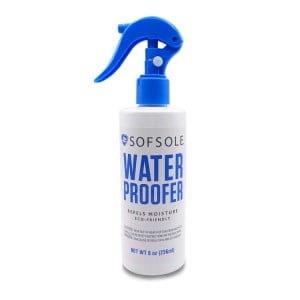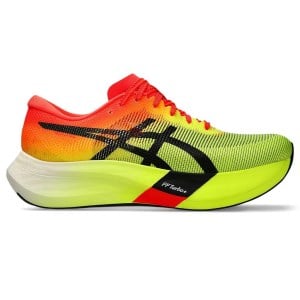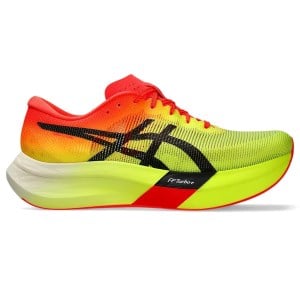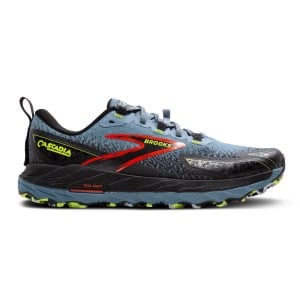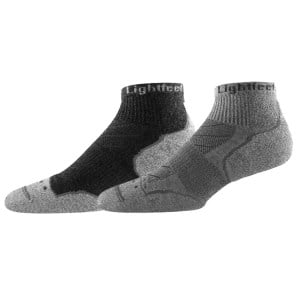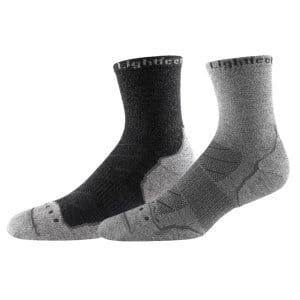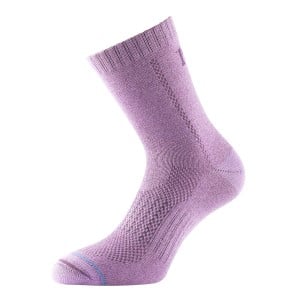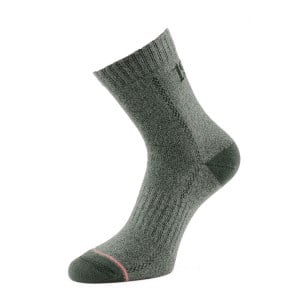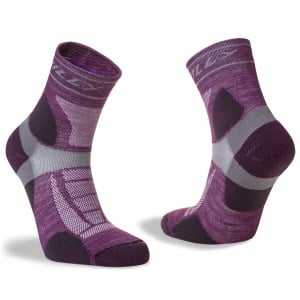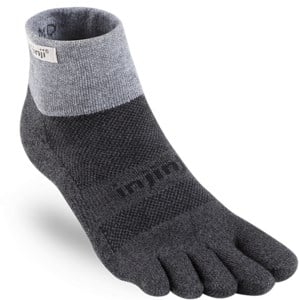The Essential Guide To Trail Running Shoes & Socks
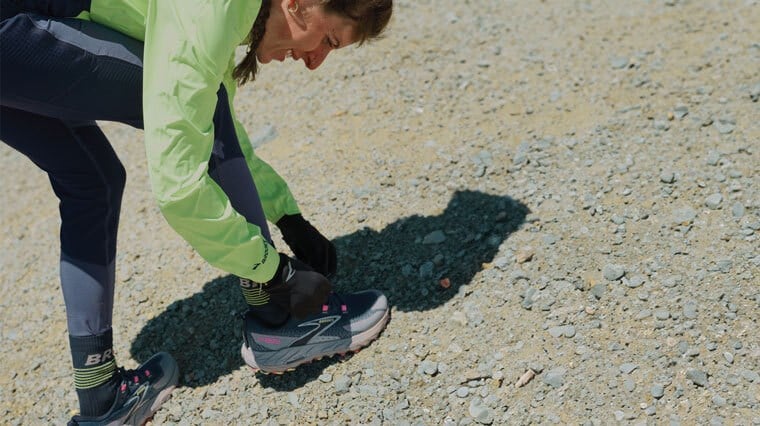
Knowing how to choose trail running shoes is key to supporting your transition from road to trail running. In Part 3 of our trail series, we dive into the details of what are trail running shoes for (and what they’re not for).
We'll uncover why trail running shoes are worth it - an essential buy for everyone from beginners to seasoned ultra marathoners. We'll discuss their unique engineering that gives you the protection, stability and traction you need to stay sure-footed on your next adventure.
Alongside learning the differences between trail running shoes, road running shoes and hiking shoes, you’ll discover the nuances within the trail shoe category to increase your comfort and performance.
You’ll find expert answers to the frequently asked questions on trail running shoes, and develop insight into two top brands that are racing to the summit to be the G.O.A.T (Greatest Of All Time) in the trail space – Hoka vs Brooks.
From well-maintained trails to technical terrain, you’ll gain knowledge into which model is an ideal fit for your running goals and the environment, with a comparative look at the Hoka Speedgoat and Hoka Challenger ATR, Brooks Caldera and Brooks Cascadia.
You’ll also learn how your running socks are a small purchase that can make a mountain of difference to your comfort and confidence, allowing your trail running shoes to work in harmony with your feet.
The Complete Trail Series
- Part 1: How To Switch From Road To Trail Running
- Part 2: How To Train For & Recover From Trail Running
- Part 3: The Essential Guide To Trail Running Shoes & Socks
Table Of Contents
1. Introduction To Trail Running Shoes
- What is special about trail running shoes?
- Are trail running shoes waterproof?
- What is the lifespan of trail running shoes?
2. When Should You Use Trail Running Shoes?
- Can trail running shoes be used for everyday use?
- Are trail running shoes good for road running/walking?
- Can I run a road marathon in trail shoes?
3. Which Trail Running Shoes Should I Buy?
- Which Hoka shoe is best for trail running?
- What trail running shoes are like the Brooks Ghost?
- Honourable mentions
- Need help choosing your trail running shoes?
4. What Socks Should You Wear For Trail Running?
- What are the best socks for trail running?
- Are thin or thick socks better for trail running?
- Why do trail runners wear tall socks?
- Why do trail runners wear compression socks?
Introduction To Trail Running Shoes
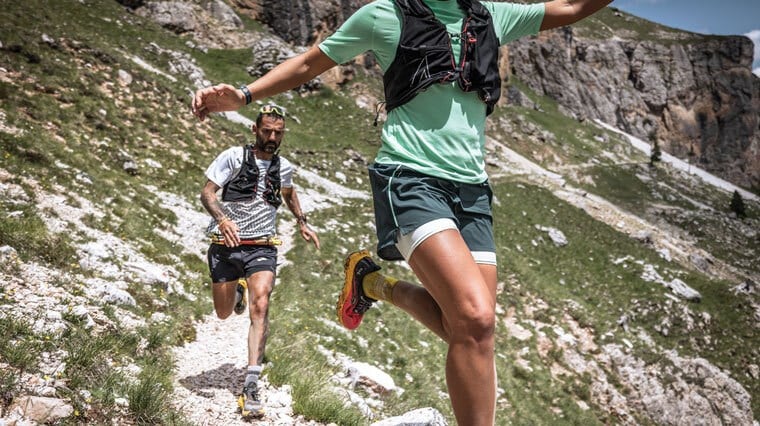
What is special about trail running shoes?
Trail running shoes make a positive difference to your comfort and performance when exploring off the beaten path. Trail running shoes provide protection, stability and traction to conquer the multi-directional, multi-terrain challenge of off-road running. Compared to road running shoes, the uppers tend to be sturdier and reinforced against natural debris, with more durable materials to prevent punctures through the fabric or toe guards that shield your feet from collisions with stones or sticks.
Many leading brands like Hoka and Brooks, transfer their signature cushioning technologies into their flagship trail running shoes, like Hoka CMEVA and Brooks DNA Loft v3 respectively – providing a balance of shock-absorbing cushioning and responsiveness. However, turning these running shoes upside-down reveals that the intended surface of trail running shoes varies greatly to road running shoes.
Trail running shoes feature strategic lug patterns, shapes and sizes to provide traction on specific terrain types – from spaced out lugs to help shed away mud, to small, tight lugs that adapt smoothly and efficiently to a variety of firmer, natural grounds. Deeper lugs are better suited to biting into softer grounds.
Lugs may also be multi-directional to provide trustworthy grip during downhill and uphill running, inspiring confidence on your adventures in natural environments and on technical terrain.
For more information on the differences between road running shoes and trail running shoes, check out Trail Running Shoes vs Road Running Shoes.
Are trail running shoes waterproof?
Even though they are engineered to tackle challenging conditions, trail running shoes aren’t necessarily waterproof. The trade-off of waterproofing is typically less breathability – keeping rain out, while potentially locking sweat vapour in.
If conditions inside your trail running shoes are warm and moist, it can increase your risk of fungal infections such as Athlete’s foot and skin-on-skin friction, encouraging the formation of blisters. Therefore, if you’re on a shorter trail run and only light rain is expected, it may be beneficial to forgo waterproof trail running shoes.
If heavy rain is on the cards, the top trail running shoe brands have you covered, with many creating their flagship models in a Gore-Tex version. Even though they don’t breathe as well as mesh uppers, Gore-Tex waterproof membranes are designed for both protection against the elements and adequate ventilation.
In particularly wet environments where you may encounter creek crossings and thick mud, or be exposed to challenging weather, Gore-Tex trail running shoes can be vital in your running toolkit – saving you from soaked, chilled feet and drenched running socks.
Check out the New Balance Fresh Foam Hierro v7, Asics Trabuco 12 and Asics Gel Sonoma 7 with their Gore-Tex versions below:
How to waterproof trail running shoes:
If you’re wondering how to waterproof trail running shoes that don’t feature a Gore-Tex membrane, Sof Sole Water Proofer spray can be a quick and effective option. It creates an invisible barrier to prevent water soaking in, keeping your go-to trail running shoes in a like-new condition for longer, without compromising on breathability.
This fast-drying formula offers long-lasting protection, with one application creating a waterproof barrier over your trail running shoes or running shoes for up to 2 months.
What is the lifespan of trail running shoes?
Generally, trail running shoes are believed to last between about 500 – 800km, however exactly where your trail running shoes fit in this range is highly dependent on the specific brand and model.
Factors such as when and where you use your trail running shoes, the terrain (e.g. muddy, rocky), the incline (e.g. steep hills), your body mass, your running gait (e.g. underpronation, neutral or overpronation), foot strike (e.g. forefoot strike, midfoot strike or heel strike) and how you care for your running shoes may also influence their longevity.
When it comes to trail running shoes, the condition of the tread pattern is particularly relevant. Like off-road tyres, the lug configuration is crucial to helping you bite into challenging terrain, and a failure to provide adequate traction can be dangerous and result in trips or falls.
The fit and feel of your trail running shoes should also be regularly assessed.
- Does your foot slip inside the shoe or does it provide adequate support?
- Does the upper have any tears or punctures?
- Has the midsole cushioning degraded, compromising your comfort and protection?
To find out more, check out When Should You Replace & Recycle Your Running Shoes?
The same criteria applies to both road running shoes and trail running shoes in terms of the condition of the upper, midsole and outsole to determine when your shoes are ready to retire.
When Should You Use Trail Running Shoes?

Can trail running shoes be used for everyday use?
It’s no secret that many runners want to live in their trail running shoes, and wonder whether they can wear trail running shoes all the time.
Ideally, neither your running shoes or trail running shoes should be used for everyday use. If you use your trail running shoes for everything from running errands to casual wear, the consistent compression of the midsole may impair their ability to spring back into shape between runs. Wearing your trail running shoes all the time will also result in faster degradation of the outsole. Unfortunately, it will compromise their cushioning, support, traction and overall performance when you do take them to the trail.
If you crave the comfort of running shoes midsoles for everyday wear, consider purchasing a road running shoe specifically for that purpose. For example, some running shoes like the Hoka Bondi 8 and Hoka Clifton 9 are popular among people in the healthcare and hospitality industry for their shock-absorbing benefits during hours on your feet, or for walking on road surfaces.
Are trail running shoes good for road running/walking?
The below questions are among the most popular queries within the trail running shoes category. The quick answer to all these questions however is no, we wouldn’t recommend it.
- Are trail running shoes OK for street?
- Can I use trail running shoes for city walking?
- Can you use trail running shoes on concrete/pavement?
To allow your trail running shoes to have as long a lifespan as possible, it’s important to use them specifically on off-road surfaces like grass, dirt, sand, mud, gravel or rocky terrain. Using them on solid, unforgiving road or pavement will cause their outsole to degrade quicker, wearing down the specialised lugs. Considering these aggressive lugs are designed to bite into softer surfaces, they’re performance on the road won't offer the same level of stability as flatter soled road running shoes.
Trail running shoes contain softer rubber underfoot compared to road running shoes. On the trail, this softer rubber translates to tacky traction on unstable off-road surfaces. However, when repetitively impacting the road, the aggressive friction between the hard surface and the softer rubber will wear down and hinder the durability and grip of the outsole.
Having a trail running shoe purely for the trail, and running shoe purely for the road/concrete/pavement in your shoe rotation is ideal. This will not only improve the longevity of both shoes, but allow you to gear up with the right shoe for the right purpose.
Can I run a road marathon in trail shoes?
If you’re thinking about wearing trail running shoes for your next road marathon, please reconsider. Wearing your trail running shoes on the road isn't recommended, even if it is possible for short distances. The exception is hybrid trail running shoes like the Hoka Challenger ATR or Brooks Divide, that have outsole engineering designed to smoothly transition from road to trail.
However, wearing any trail running shoe for marathon distances, even hybrid designs, not only puts your shoes at risk of damage, but your feet. They will likely not offer the flexibility needed to comfortably conquer endurance road running, and may impair your performance as a result. Furthermore, the deep lugs of trail running shoes that are designed for softer surfaces, may feel jarring when running on hard, unforgiving road surfaces, potentially increasing your risk of injury.
With stronger and more protective uppers, trail running shoes also tend to be less breathable than the airy mesh or knit uppers of road running shoes. Road running shoes are preferable for urban or city surfaces for their lightweight designs and increased ventilation – allowing you to run faster to chase your PB while keeping your feet in cool conditions for longer runs.
Consider the following road running shoes for your next marathon:
-
Asics Gel Kayano 31 - Womens Running ShoesFree Delivery in Aus$279.99 $219.99
-
Asics MetaSpeed Edge Paris - Unisex Road Racing ShoesFree Delivery in Aus$329.99 $279.99
-
Asics MetaSpeed Sky Paris - Unisex Road Racing ShoesFree Delivery in Aus$329.99 $279.99
Is it OK to use your trail running shoes for hiking?
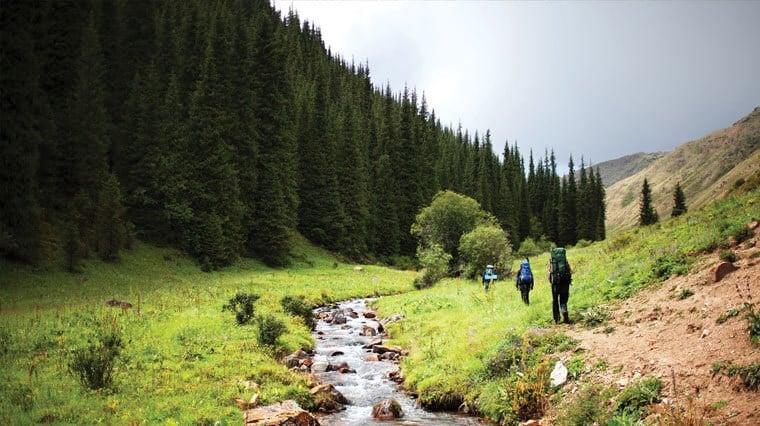
The short answer is yes, you can use your trail running shoes for hiking and bushwalking, but many factors should be considered in your decision.
Many hikers and bushwalkers prefer trail running shoes to hiking shoes for their increased agility and breathability. Keeping the needs of trail runners in mind, trail running shoes are lighter than hiking shoes, being tailored to faster paces and to ward off fatigue.
Hiking shoes on the other hand are more robust than trail running shoes, featuring increased support, stability and a sturdier outsole. This can be critical when navigating the terrain when encumbered with a hiking pack, especially in more technical environments, to avoid rolling an ankle.
When you require addition stability, a hiking boot with high levels of ankle coverage and support is likely the better fit, whereas low top hiking shoes and trail running shoes offer greater mobility of the ankle joint.
If you're travelling light with a running hydration vest at a walking pace, and the terrain isn't overly rugged, a trail running shoe may be your go-to ride. Assessing the specific terrain and conditions can help guide your decision of trail running shoes vs hiking shoes.
Both typically have protective features such as toe guards, and many hiking shoes and trail running shoes are available in waterproof, Gore-Tex designs. Brands such as Hoka and On Running feature both hiking shoes and trail running shoes in their range.
Hiking shoes for women:
Hiking shoes for men:
-
The North Face Vectiv Exploris 2 Futurelight - Mens Hiking ShoesFree Delivery in Aus$319.99 $223.99
Which Trail Running Shoes Should I Buy?
When you’re gearing up for trail running, there are several factors to consider regarding which is the right trail running shoe for you. Before continuing reading this article, ask yourself:
- Do I prefer a trail running shoe with maximum cushioning, balanced cushioning or minimalist cushioning? (i.e. plush protection vs improved ground feedback)
- What type of terrain will I take my trail running shoes on? (e.g. highly technical terrain, well-maintained trails or a variety of surfaces requiring multi-terrain traction)
Below, we discuss some of the best trail running shoes for 2024 and beyond from two of the most popular brands in the trail space – Hoka and Brooks.
If you’re wondering which is better, Hoka or Brooks, this is a personal decision. Perhaps the most distinguishing factor between these two brands is the cushioning. Hoka offers a supremely plush, high stacked feel whereas Brooks, known for their durability and reliability, typically offer a more traditional ride with minimal to moderate cushioning.
However, as brands like Brooks evolve, developing models that are a natural fit in the max cushioned category (e.g. Brooks Caldera), runners have more choices than ever to cater to modern preferences.
Which Hoka shoe is best for trail running?
There has been a boom in popularity for the running shoe brand Hoka in recent years, with runners gravitating to their max stacked cushioning for shock-absorbing comfort and confidence.
It was the popularity of Hoka among ultra runners first and foremost that led to its expansion into the larger world of running. In fact, in 2009, Hoka grew out of the vision to create an ultramarathon shoe with the aggressive traction, protection and speed needed to handle the steep and rugged downhills of mountain races. From there, they developed ultra-cushioned designs to protect the feet of ultra runners over epic distances.
Today there is a Hoka running shoe for every type of running workout and ability. They continue to be characterised by their thick, soft midsoles that provide a protective barrier between your feet and the ground.
When trail running, this means you don’t have to feel every sharp stick or stone underneath your feet, while helping to ward off fatigue from repetitive foot strikes during longer trail runs. This combined with a stable base put Hoka on the radar of the modern trail runner.
Both the Hoka Speedgoat and Hoka Challenger ATR are flagship trail running shoes from Hoka, and in their newest generations contain recycled materials to support eco-conscious trail blazers.
Consistent with the Hoka brand, the latest models in these trail shoe families both feature a 5mm shoe drop for a balanced, natural feel from heel to forefoot compared to traditional running shoes. This is achieved without compromise to the high stacked protection Hoka is celebrated for.
Below we discuss the benefits of both the Hoka Speedgoat 6 and Hoka Challenger ATR 7 trail running shoes to highlight their differences and determine which is the right fit for you.
Hoka Speedgoat 6: Unrivalled speed & traction for mountainous, technical terrain

The Hoka Speedgoat is an award-winning trail running family that takes inspiration from the hooves of mountain goats to provide confidence-inspiring grip to reach new altitudes. From 5K trail runs to multi-day ultramarathons, this trail running shoe is fast, robust and ready to tackle a variety of distances.
In its most recent evolution, the Hoka Speedgoat 6, the upper has been re-imagined with a breathable woven textile to keep your feet cool as you shift the pace up a gear.
The combination of an internal chassis and dual-gusset tongue keeps your feet secure and locked-in on the platform, for reliable support that’s integral to trail running. Hoka’s CMEVA foam has also been given an upgrade, providing enhanced responsiveness and resiliency in a lighter ride.
Turn the Hoka Speedgoat 6 upside-down, and you’ll see the hoof-like outsole configuration, with durable Vibram Megagrip and aggressive 5mm lugs for steep uphill traction to dominate rugged or loose terrain. The strategic lug pattern supports controlled speed - allowing you to cut seconds off your PB whether running on flat trails or flying down challenging descents.
However, if you're looking for a hybrid trail running shoe that can go smoothly from road to trail, the Hoka Challenger ATR 7 is potentially the better option for you.
Ideal for trail runners seeking: Increased durability, protection and traction on steep or technical terrain – from mountainous slopes and snow, to rocky trails and thick mud.
Similar shoes: Brooks Cascadia
Hoka Challenger ATR 7: Superb comfort and versatility for most trails and city runs
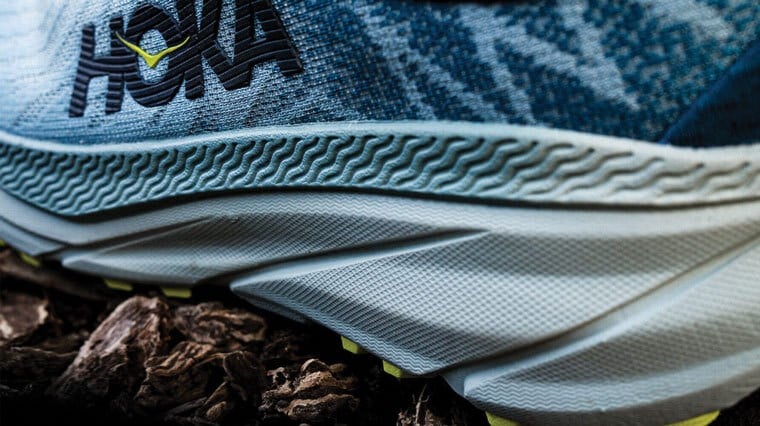
The Hoka Challenger ATR 7 delivers serious adaptability, able to conquer light to moderately challenging trails and road runs. From dirt and gravel to concrete, this hybrid design is surprisingly lightweight for the high level of protection you get out of it.
Wrapping your feet in a breathable and supportive engineered mesh upper, you stay cool and confident in every environment.
Like the Hoka Speedgoat 6, it features Hoka’s CMEVA foam for shock-absorbing cushioning over long distances and on most terrains. The consistent comfort beneath makes it feel seamless as you transition between multiple surfaces – injecting your running workouts with more variety.
The multi-terrain, 4mm lugs are strategically shaped and positioned. The centre of the outsole features small, densely packed lugs and the border of the outsole features more prominent, aggressive lugs for stability when the technical challenge of the trail increases.
Underneath, Durabrasion rubber acts as your lightweight shield against hard urban and trail surfaces, protecting against repetitive impacts to endure the distance.
However, if the world beneath your feet is dramatically steep, rocky or icy, the Hoka Speedgoat 6 is potentially the better option for you.
Ideal for trail runners seeking: Lighter weight, higher adaptability, breathability and multi-terrain traction in urban/city and trail environments
Similar shoes: Brooks Divide 4
What trail running shoes are like the Brooks Ghost?
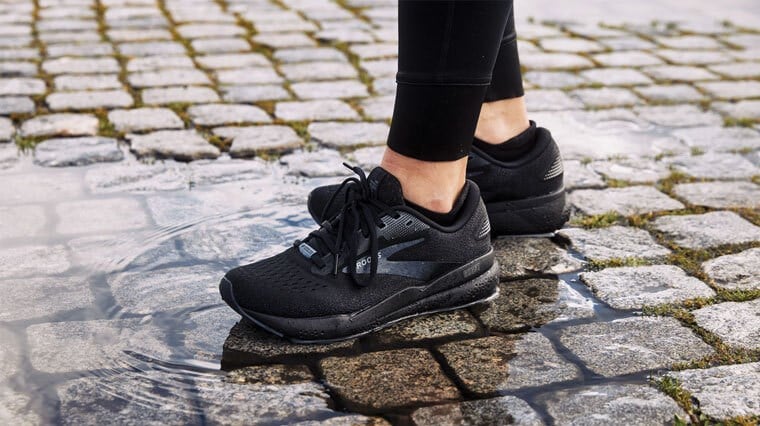
Brooks running shoes are known for their durability and reliability, with the brand shifting to specialise in running footwear since the early 1970s. With their dependability, Brooks has earned its place as one of the leading brands in the industry. It’s no secret why runners are craving a comparable feel to the best-selling Brooks Ghost road running shoes (above) to conquer the trail.
First launching in 2008, the Brooks Ghost have long since been the brand’s signature model when it comes to a sweet spot of cushioning and versatility for daily training. When weighed up against the Brooks Glycerin, the cushioning feels less soft and more balanced in the Brooks Ghost – which may be exactly what you’re searching for.
The Brooks Ghost 16 road running shoes, Brooks Glycerin 20 road running shoes and Brooks Caldera 7 trail running shoes - to name a few - all feature Brook’s nitrogen-infused DNA Loft v3 cushioning.
This innovative midsole foam offers plush protection, smooth shock absorption and reliable responsiveness. However, Brooks optimise the thickness of this cushioning and fine tune the engineering of each model to target particular preferences and purposes.
The previous generation of this cushioning, DNA Loft v2, continues to run strong in the Brooks Cascadia 17 trail running shoes, and its newest evolution, the Brooks Cascadia 18.
Below we discuss the differences between the Brooks Caldera 7 and Brooks Cascadia 17/18, alongside their similarities to the Brooks Ghost, to determine which is the right fit for you.
Brooks Caldera 7: Max cushioned for long or easy-going trail runs
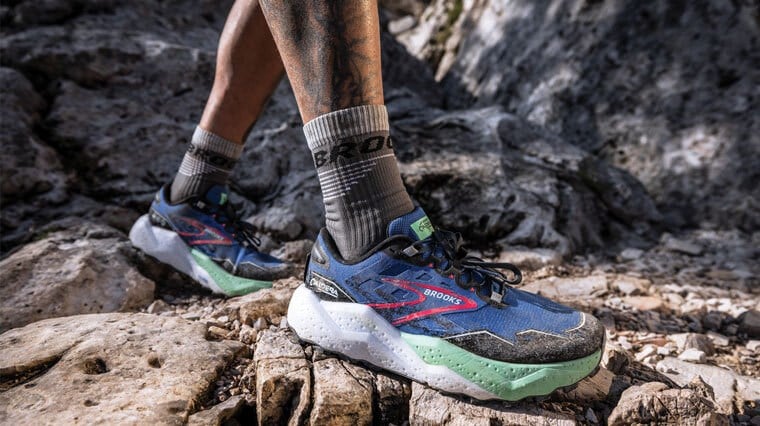
If you’re a fan of the Brooks Ghost 16, the Brooks Caldera 7 is a natural choice for comfort on the trails. It is among the most cushioned models in the Brooks trail running shoes family – perhaps making it more similar to the Brooks Ghost Max - but its intuitive stability helps keep the feel balanced.
Although the intention for the terrain is obviously different, the philosophy behind the Brooks Caldera and Brooks Ghost is similar – a shoe that allows you to flow into your stride at easy-going paces, with enduring comfort the priority over speed. Short of Brooks releasing a Ghost Trail model, the Brooks Caldera 7 meets the criteria of what Brooks Ghost runners crave.
Hugging your feet with a spacious fit and lightweight engineered mesh, the breathability of the Brooks Caldera 7 makes it summer-ready, with an airy feel that’s comparable to the Brooks Ghost 16 and true to the brand.
The Brooks Caldera 7 excels at protecting your feet over long distances. It's free of a rock plate, however the shock-absorbing and bouncy DNA Loft v3 foam itself provides a protective barrier between your feet and the rugged terrain or sharp debris beneath.
The heel drop is identical from the Brooks Caldera 7 to the Brooks Ghost Max, being 6mm for a more natural stride yet on a higher stack height, whereas the Brooks Ghost 16 features a more traditional heel drop of 12mm.
The Brooks Caldera 7 supports confident strides with a wide base and strategically raised midsole foam walls, complementing the plush cushioning from the ground up. Beneath the Brooks Caldera 7, the TrailTack Green outsole (made of 25% recycled materials) provides reliable wet and dry traction.
Ideal for trail runners seeking: A go-to, soft and bouncy trail shoe that prioritises comfort from everyday trail runs to long distances.
Similar shoes: Hoka Stinson 7
Brooks Cascadia 17 & Brooks Cascadia 18: Adaptable all-rounder to reach new summits
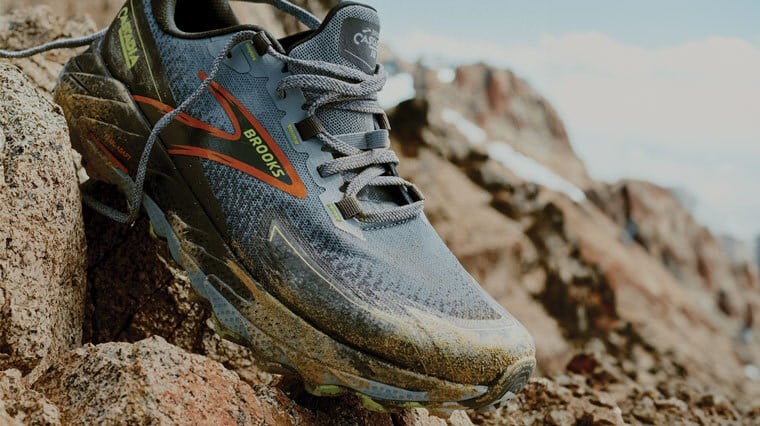
“Ghost for the road. Cascadia for the trail” has been a common thought shared by many Brooks runners.
Whereas the Brooks Caldera 7 excels at easy to moderate trails, the Brooks Cascadia is happy to step up the technical challenge, adaptable to meet the demands of a variety of paces, terrains and summits – to the point where it can be called a mountain trail running shoe.
This is royalty among Brooks trail running shoes, and is frequently compared to the Brooks Ghost – as if the vision behind the Brooks Ghost has been wrapped in a more durable upper, firmer midsole and trail-worthy outsole.
The Brooks Cascadia family tends to run narrower than the Brooks Caldera 7, particularly at the midfoot, offering a more race-ready feel. A sturdy yet airy upper passes the breathability test without breaking a sweat.
The DNA Loft v2 midsole is comparatively firm when weighed up against the DNA Loft v3 midsole of the Brooks Caldera 7, while offering a degree of flexibility. In the Brooks Cascadia 17 and Brooks Cascadia 18, a rock plate provides additional protection for challenging, technical terrain.
The Brooks Cascadia 17 and Brooks Cascadia 18 are on an 8mm shoe drop, making them a middle ground between the 6mm drop of the Brooks Caldera 7 and 12mm drop of the Brooks Ghost 16.
The Trail Adapt system of the midsole provides a stable, protected feel, keeping you steady when the terrain turns rough – with the DNA Loft v2, ballistic rock shield and zonal outside pods creating this adventure-ready formula.
Similarly to the Hoka Speedgoat, the split forefoot outsole design takes inspiration from mountain goat hooves, providing controlled traction from wet surfaces to rocky terrain.
Ideal for trail runners seeking: An adventure-ready, all-terrain trail running shoe to climb up mountain peaks and conquer tough conditions with a protective ride and high traction.
Similar shoes: Hoka Speedgoat 6
Honourable Mentions
Hoka Torrent 3
The Hoka Torrent 3 trail running shoes offer a swift ride on smoother trails, and steers away from the max cushioning Hoka is known for with its close-to-ground feel.
With minimal cushioning compared to others in the Hoka family, it provides a fast feel, while giving you a more intuitive connection to the world beneath your feet. The ProFly midsole offers a stable experience, however, unlike the Hoka Speedgoat 6 or Hoka Challenger ATR 7, you're going to feel the pebbles underfoot due to reduced cushioning and the absence of a rock plate.
Depending on where you land in the cushioning vs feedback debate feeling more may be a preferred option for you. However, this also makes the Hoka Torrent 3 best suited to shorter trail runs, on terrain that isn't highly technical or rocky.
The upper provides plush protection and a distraction-free fit to hug your feet securely, while boosting the breathability compared to the Hoka Torrent 2.
Brooks Catamount
The Brooks Catamount completes the performance trail running trio from Brooks that includes the Brooks Caldera and Brooks Cascadia. For loyal Brooks Ghost fans, the nimble Brooks Catamount may be a wild card – but if you’re seeking lightweight versatility and a fast feel from the supportive and responsive DNA Flash midsole, it may be exactly what you need to energise your trail experience.
The DNA Flash midsole is reserved for Brooks' fastest running shoe offerings, so it steers away from the ‘comfort over speed’ philosophy of the Brooks Ghost. The SkyVault Trail Plate (TPU propulsion plate) in the Brooks Catamount also provides the boost you need for powering uphill.
New Balance Fresh Foam More Trail v3
Although Hoka vs Brooks is a popular topic of conversation in the trail running world, they're certainly not the only options. Rivals like the New Balance Fresh Foam More Trail v3 are also in the race to be the best trail running shoe for you.
New Balance's high stacked trail model is praised in the running community for its enduring comfort, shock-absorbing and bouncy Fresh Foam X midsole and reliable protection to roll over rugged terrain effortlessly.
Need help choosing your trail running shoes?
Please contact our Sportitude shoe experts for running shoe advice and guidance on achieving your ideal fit.
With the passion and expertise of the Sportitude team and the insight of real-world data, you'll find a trail running shoe that meets your preferences in fit and function to support your goals.
What Socks Should You Wear For Trail Running?
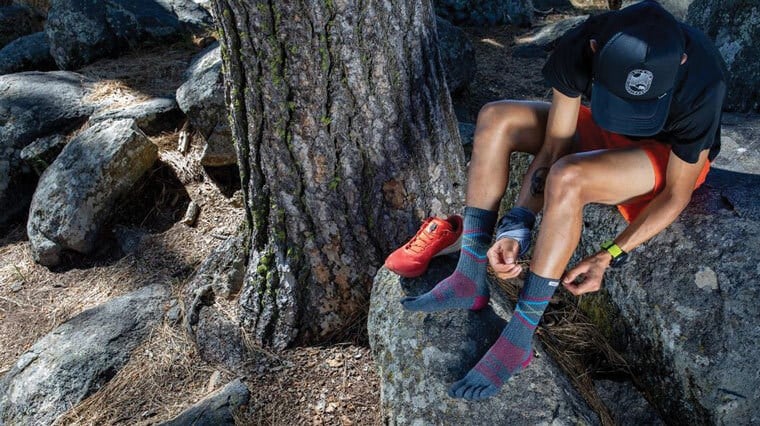
What are the best socks for trail running?
The running socks you wear can be transformative in terms of your overall comfort. Whereas road running socks are designed for anti-blister protection, lightweight breathability and sweat-wicking comfort, trail running socks need to meet not only these criteria, but also have the durability and protection needed in natural environments.
Specialised synthetic or natural materials like Merino wool help keep your feet dry while trail running, allowing you to conquer sweat and the elements.
Check out the following blogs to discover why running socks are an essential part of your running kit:
- 5 Reasons You Should Use Technical Running Socks
- What Type Of Technical Running Sock Is Right For Me?
Check out some of the best performance trail running socks below to complement your trail running shoes and stay adventure-ready:
Lightfeet Evolution Mini Crew trail running socks & Lightfeet Evolution Half Crew trail running socks
Made in Australia and designed by sports podiatrists, Lightfeet running socks are among the most popular, anti-blister socks in the market. They're celebrated for their padded, targeted cushioning and strategic ventilation for heat and sweat control.
Lightfeet's best-selling Evolution running socks range is now available in adventure-ready designs that stay honest to the Seamless Technology, arch support and moisture-managing Coolmax yarns of the brand.
The FormFit design provides a left and right specific fit to conform to your anatomy. The X-Static fibres keep your feet in healthy conditions, offering anti-odour and anti-fungal protection, while providing the durability you need to conquer the trail.
-
Lightfeet Evolution Mini Crew - Trail Running Socks$34.99 $29.99
-
Lightfeet Evolution Half Crew - Trail Running Socks$34.99 $29.99
1000 Mile All Terrain women's trail running/hiking socks & 1000 Mile All Terrain men's trail running/hiking socks
The 1000 Mile All Terrain trail running and hiking socks feature a blend of natural and synthetic fibres for comfort on your explorations. True to the innovation of 1000 Mile running socks, they feature a double layer ‘sock within a sock’ design for friction-reducing, anti-blister protection and enhanced durability.
The 100% Tactel inner layer provides sweat-wicking comfort and a foot-conforming fit. The outer layer is made with 45% Merino wool, pulling sweat to the exterior of the fabric, and pairs with the softness of cotton for on-the-run luxury.
The Merino wool offers slightly moisture repellent properties, keeping your feet dry and comfortable. Complete with Air flow channels for breathability, supportive arch bracing and flat toe seam, they offer a secure and distraction-free fit to coast over the trail.
-
1000 Mile All Terrain Womens Trail Running/Hiking Socks$38.95 $34.99
-
1000 Mile All Terrain Womens Trail Running/Hiking Socks$38.95 $34.99
-
1000 Mile All Terrain Mens Trail Running/Hiking Socks$38.95 $34.99
Hilly Trail Anklet running socks
The Hilly Trail Anklet running socks feature 33% Merino wool which is naturally thermo-regulating – keeping your feet at an optimal temperature based on the conditions, and providing warmth when the temperature drops. The Lycra Sport fibre creates a stretchy, second-skin fit for a natural feel.
A ventilated upper, mid-level cushioning, arch grip and just-right length for extra protection in trail environments makes it a go-to for your next adventure.
-
Hilly Trail Anklet Womens Running Socks - Medium Cushioning$34.95 $30.99
-
Hilly Trail Anklet Running Socks - Medium Cushioning$34.95 $30.99
Injinji Trail Midweight Mini Crew Performance Toe Socks & Injinji Spectrum Trail Midweight Mini Crew Running Socks
The Injinji Trail Midweight mini crew toe socks allow your feet to fully engage in natural environments. Toe socks have multiple benefits, conforming to your anatomy and allowing each toe to move independently for stabilisation.
With the individual toe sleeves, Injinji toe socks eliminate skin-on-skin friction. Combined with the CoolMax sweat-wicking fibres, they reduce the risk of blisters developing and fungal infections.
The Injinji trail running socks range is optimised for off-road, with protective cushioning, breathable mesh tops and a secure, stay-put fit around the ankle to keep trail debris out in nature where you can enjoy them.
-
Injinji Trail Midweight Mini-Crew Performance Toe Socks$34.99
-
Injinji Spectrum Trail Midweight Mini Crew Running Socks$34.99
Are thin or thick socks better for trail running?
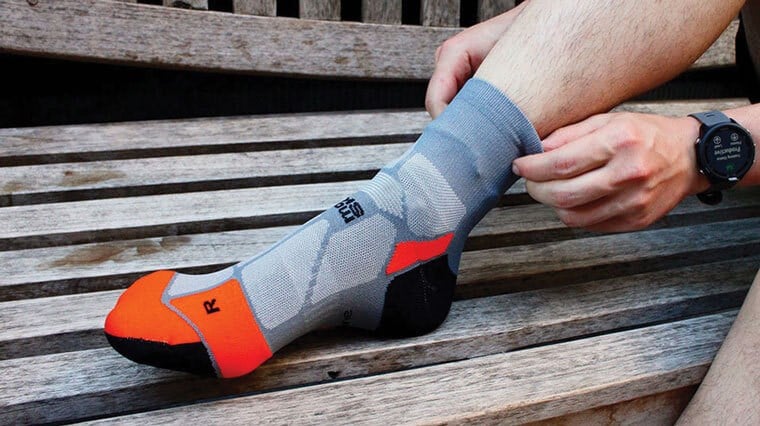
The thickness of your trail running socks should be based on multiple factors including your personal preferences, the temperature/conditions and the fit within your trail running shoes.
Durability vs breathability
Typically, thicker trail running socks will be more durable, whereas thinner trail socks may offer more breathability, especially when made of performance fabrics featuring strategically placed ventilation panels.
With increased durability comes increased protection, helping provide a barrier against scrapes from sharp branches or twigs. Long, thick trail running socks made with densely woven fabric may also help discourage leeches, ticks and mosquitoes when worn over your running tights – leaving less skin exposed. However, please know that leeches have a reputation for being able to bite through socks, so further preventative measures may be required.
However, creepy crawlies aren’t the only thing you want to be protected from on the trail. Sweat build-up in your trail running shoes can create conditions where fungal infections like Athlete’s foot thrive. This is where lightweight, sweat-wicking running socks can shrine – allowing your feet to breathe even in warm conditions, and keeping them in a dry and healthy environment.
Temperature & conditions
Typically, a thinner sock will keep your feet cooler than a thicker sock. However, the thickness of the fabric is not the only factor that counts here. The fabric material itself can be game-changing.
In terms of temperature regulation and protection against the elements, many trail running socks feature Merino wool blends. Merino trail running socks keep your feet dry and warm with naturally water-repelling, sweat-wicking and thermo-regulating properties, without overheating. This makes them ideal all-year round, even in the rain.
For summer trail runs in sunny conditions and on well-maintained trails, you may prefer the lightweight feel and sleek fit of thin road running socks like Steigen which are made of synthetic performance fibres.
Cushioning & fit
Once you buy the best trail running shoes for you, it’s important to find a running sock that will work in harmony with it. You may prefer a thicker sock in a more voluminous shoe to help provide ‘padding’ for a more secure feel, or a thinner sock in a narrower shoe to complement the sleek fit.
The thickness may also be tailored to provide higher or lower levels of cushioning. This choice may come down to whether you want to bolster the cushioning of your trail running shoes, or keep the cushioning minimalist to help support your proprioception and gain more feedback from the world beneath your feet.
Why do trail runners wear tall socks?
On the trail, you may be exposed to the elements like wind and rain, or sharp natural debris. Typically, trail running socks are available in longer lengths like crew heights, compared to the popular no show or low height running socks of the road running, parkrun, half marathon or marathon scene.
Above-the-ankle socks provide additional coverage to help protect your skin on rugged and challenging terrain – where anything from mosquito bites to scratches from branches are common. It also extends the warmth the sock can provide to your lower limbs, in the case of cold or windy trail runs.
Why do trail runners wear compression socks?
Especially during endurance runs like marathons or ultramarathons, compression socks can be a valuable part of your running kit. These are available in a variety of heights, but you may frequently encounter trail runners wearing a combination of running shorts and high compression socks, hitting just below the knee and hugging your calves. Tall compression socks can also create a stabilising feel and improve proprioception, the awareness of your body in space.
Compression socks boost circulation, increasing the transport of oxygen and nutrient-rich blood to your active muscles to support muscle movement and speed up recovery. They may also decrease muscle vibrations, helping ward off fatigue so you move more efficiently and your legs feel energised for longer. Compression socks may also assist in alleviating soreness and swelling post-run.
If you liked this, you'll love:
Part 1: How To Switch From Road To Trail Running
Part 2: How To Train For & Recover From Trail Running
Happy trail running!

